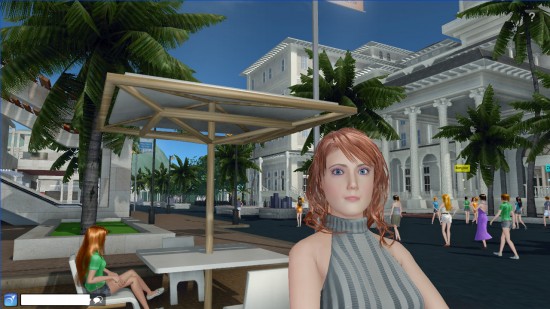Blue Mars is currently testing a cloud-based streaming service, which will soon allow users to log into the high-end, graphics-rich immersive world via a simple browser interface.
“We’re running it now, with cloud servers in LA,” said Jim Sink, CEO of Avatar Reality, the parent company of Blue Mars.
The company’s own servers are located at company headquarters, in Honolulu.
Avatar Reality is currently working with California-based cloud services vendor Otoy LLC, but is open to other providers, Sink told Hypergrid Business.

“We’re in talks with all the major cloud service providers,” he said. “I expect we’ll be announcing their [Otoy’s] service, but we won’t be locked into their environment.”
The timing of the release date depends on the partner, he added.
“I do expect they will make the announcement soon,” he added.
Ease of access
Web-based access will help corporate users, he added, such as those in the process of signing up for Blue’s Mars’ new business park, OnLand.
“People in the corporate world have more stringent or greater constraints on the types of executables they can put on their machines,” Sink said.
Corporate users are also working on older equipment, he said. The Blue Mars client requires a state-of-the-art machine with a high-end graphics card.
A Web-based, streamed application would eliminate the hardware requirements.
“It’s going to run on a four-year-old corporate laptop, a Macbook, a netbook,” he said — and didn’t stop there.
“In the future, you’re seeing a lot of thin clients, smart phones, tablet devices, those machines are always going to be underpowered,” he said. “I think we’re at a new inflection point.”
In addition, corporate users are familiar with Web-based applications such as WebEx and GoToMeeting.
“The typical collaboration applications don’t require any significant technical knowledge of the user and don’t have any demanding hardware requirements,” he said. “For these types of spaces, these types of experiences, they need to be as easy as the Web and as fast as ‘right now’.”
The way the cloud-based service will work is that a separate machine will run the Blue Mars client, and then send a video stream of its screen to the user. As the user enters commands — for example, to move forward — those commands are passed on to the machine running the client, which executes them and, in turn, sends them on to the Blue Mars server.
This extra step will add delays, which could be problematic for people playing fast-paced video games.
“Imagine if you were playing Guitar Hero and the latency was not consistent — it would break the game,” said Sink. “Fortunately, virtual environments aren’t twitch-based.”
The extra step also adds significant costs. For each user accessing Blue Mars via a Web stream, there will need to be a separate machine running the client software and sending out that stream. Sure, those machines can be virtualized and several packed together on a single high-powered server, but it’s still a lot of extra hardware — especially if the Web access means that Blue Mars suddenly sees a large spike in new users.
To offset these costs, the users may be asked to pay an extra fee, Sink said. Or the region owners who want to enable Web access to their environments may cover the additional costs, he added.
One side benefit of Web-based streaming is that no actual software is running on the user’s machine — and that means that the user can’t tamper with that software, to, say, inject malicious code.
“We all want to avoid the situation where offensive content is loaded into the corporate environment,” Sink said. “It’s something that corporate customers have little tolerance for.”

Pre-loaded environments
Web streaming is particularly suited to a virtual environment like that of Blue Mars, where all the content is loaded ahead of time, Sink said.
Consider a Web browser. Whenever a user visits a page, it is loaded fresh from the server. As a result, the user can interact with the page — commenting on a news article, posting an opinion in an online forum, or using a Web-based email client or word processor.
Similarly, some virtual environments load up each new area that a user visits when he or she enters it, and then continues to update the area in real time. As a result, users in Second Life and OpenSim platforms can move furniture around, change the landscape, or build entire buildings from inside the world — even working with other people to create or modify the virtual environment. Because of this, a platform like Second Life or OpenSim can be scaled to any geographical size, just as the Web is able to scale to any number of Websites.
The downside, however, is that each area has to be small enough to download in its entirely when new people arrive. This puts limits on the number of objects, images, and interactive scripts that can be gathered in one place. Too much stuff, and users will give up and leave before everything loads up.
Graphics-rich online video games, however, pre-load the entire world. Players often get the world on a disk that they install, and only download small update packs as they need them.
The advantage is that a single object in Blue Mars can be composed of millions of polygons — multiple orders of difference from a Second Life or OpenSim environment, Sink said.
“The trade-off is that we don’t do the same kind of real-time content development that they can,” he said. “The dream of you and I in a room together building a chair is not something we’re designed for.”
Today, Blue Mars users have to download the entire virtual environment to their computers before they can enter Blue Mars. Then, once they’re in the world, they can’t make changes to it that other users can see. If a user wants to change the color of her office ceiling in Blue Mars, she will need to leave the platform, pull up a 3D design program, edit the office ceiling color, then upload the new building up to Blue Mars, where the changes will be pushed out to other users as part of their updates.
Users who want to visit the OnLand business park, for example, have to first download the entire OnLand environment. If they wish to leave OnLand and travel to another part of Blue Mars where they haven’t been before, they will have to wait while the destination is downloaded, which can take several minutes or more.
With Web streaming, these downloads are no longer necessary — the cloud-based machines running the viewers on behalf of users will already have the entire Blue Mars environment installed.
“We can put all the data on the rack so that it’s all there immediately,” Sink said. “It makes a big difference in how we can coordinate large numbers of users.”
- Analysts predict drop in headset sales this year - March 25, 2025
- OSgrid enters immediate long-term maintenance - March 5, 2025
- OSgrid wiping its database on March 21: You have five weeks to save your stuff - February 15, 2025
